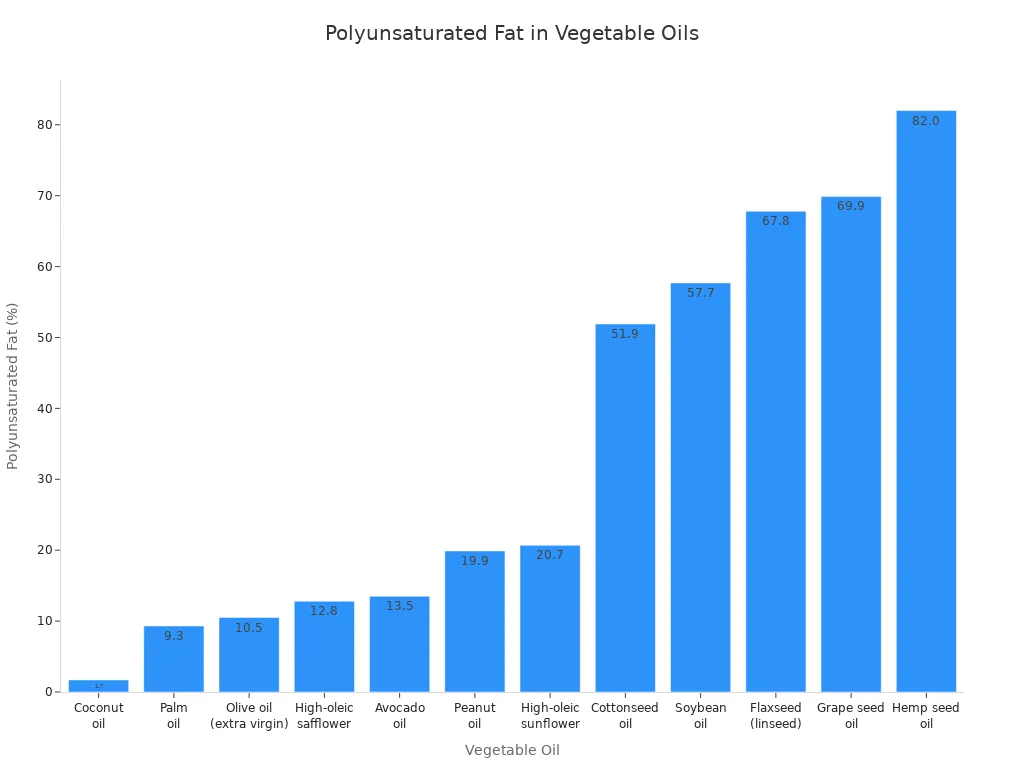What Are the Health Benefits of Polyunsaturated Fats

You help your heart and boost your overall health when you choose polyunsaturated fats over saturated fats. Research shows that people who eat more polyunsaturated fats have lower rates of heart disease, less inflammation, and a reduced risk of dying from any cause. Many studies found that replacing saturated fats with these healthier fats can lower blood pressure and support better long-term health. The benefits of polyunsaturated fats even extend to lowering the risk of chronic conditions, which makes them a smart choice for your daily meals.
Key Takeaways
Polyunsaturated fats support heart health by lowering bad cholesterol and reducing the risk of heart disease.
Omega-3 and omega-6 fats are essential types that help your brain, nerves, growth, and energy.
Eating foods like fatty fish, nuts, seeds, and vegetable oils provides important polyunsaturated fats.
Replacing saturated fats with polyunsaturated fats improves cholesterol and lowers inflammation.
Balance your intake of omega-3 and omega-6 fats to get the best health benefits and avoid risks.
What Are Polyunsaturated Fats
Definition
You may hear about polyunsaturated fats when people talk about healthy eating. These fats belong to a group called polyunsaturated fatty acids, or PUFAs. Scientists define polyunsaturated fats as fats that have two or more double bonds in their chemical structure. This means their molecules have several places where hydrogen atoms are missing. Because of these double bonds, polyunsaturated fats usually stay liquid at room temperature.
Your body needs some of these fats to work well. Some polyunsaturated fats are called "essential" because your body cannot make them. You must get them from food. These fats help build cell membranes and protect the covering around your nerves. They also help your blood clot, your muscles move, and your body control inflammation. Nutrition experts say that people, especially pregnant and breastfeeding women, should eat enough polyunsaturated fats to support healthy growth and development.
Tip: Polyunsaturated fats are often found in plant oils, nuts, seeds, and fatty fish. Try to include these foods in your meals for better health.
Types: Omega-3 and Omega-6
You will find two main types of polyunsaturated fats: omega-3 and omega-6. The difference between them comes from where the first double bond sits on the fat molecule. In omega-3 fats, the first double bond is at the third carbon atom from the end of the chain. In omega-6 fats, it is at the sixth carbon atom. This small change makes a big difference in how your body uses them.
Omega-3 fats include alpha-linolenic acid (ALA), which you get from plants, and other types like EPA and DHA, which come from fish. Omega-6 fats include linoleic acid (LA), which is common in many vegetable oils. Both types are important for your health, but they have different jobs in your body. Omega-3 fats help your brain and heart, while omega-6 fats support growth and energy.
Type | Main Example | Common Sources | Key Role in Body |
|---|---|---|---|
Omega-3 | Alpha-linolenic acid (ALA) | Flaxseed, walnuts, fish | Brain, heart, nerves |
Omega-6 | Linoleic acid (LA) | Sunflower oil, corn oil | Growth, energy |
You need both types, but keeping a good balance helps your body stay healthy.
Benefits of Polyunsaturated Fats

Heart Health
You support your heart every time you choose foods rich in polyunsaturated fats. Many studies show that people who eat more of these fats, especially from sources like oily fish, nuts, and vegetable oils, have a lower risk of heart disease. When you replace saturated fats with polyunsaturated fats, you can reduce your risk of coronary heart disease by about 25%. This change also helps lower your chances of heart attacks and other heart problems. Omega-6 fats, such as linoleic acid, play a big role in reducing cholesterol and keeping your arteries clear. These fats do not increase inflammation, so you can feel confident about adding them to your meals. The benefits of polyunsaturated fats for heart health are clear and well-supported by research.
Tip: Try swapping butter or lard for sunflower oil or soybean oil when cooking to help your heart.
Cholesterol and Triglycerides
Polyunsaturated fats help you manage your cholesterol and triglyceride levels. When you eat these fats instead of saturated fats or refined carbohydrates, your blood fats improve. Here are some ways polyunsaturated fats work in your body:
Lower triglyceride levels, especially when you replace saturated fats or carbs with them.
Reduce LDL (bad) cholesterol, which helps protect your arteries.
Keep HDL (good) cholesterol steady, so your body can remove extra cholesterol.
Support healthy blood fat levels, which lowers your risk of heart disease.
A well-known study found that switching just 5% of your daily calories from saturated fats to polyunsaturated fats can make a big difference in your cholesterol numbers. The benefits of polyunsaturated fats include a steady drop in triglycerides, which is important for your heart and blood vessels.
Brain and Nerve Function
Your brain and nerves need polyunsaturated fats to work their best. Omega-3 fats, such as EPA and DHA, help your brain cells communicate and protect them from damage. When you eat enough of these fats, you may notice better memory, clearer thinking, and even a better mood. Some studies show that older adults who eat more omega-3s have a lower risk of mental decline and dementia. These fats also help your nerves send signals, which keeps your muscles and senses sharp.
Omega-3s improve blood flow in the brain and support learning and memory.
They help protect your brain from inflammation and cell damage.
Children and teens who eat fish or foods rich in omega-3s may do better in school and sports.
The benefits of polyunsaturated fats for your brain and nerves are important at every age.
Disease Protection
Polyunsaturated fats help protect you from many chronic diseases. They lower inflammation in your body, which can reduce your risk of problems like arthritis, diabetes, and even some cancers. Diets high in these fats, such as the Mediterranean diet, show lower levels of inflammation markers in the blood. This means your body is less likely to develop diseases linked to long-term inflammation.
Omega-3 fats can slow the growth of some cancer cells and help your immune system fight disease.
These fats help your body absorb fat-soluble vitamins like A, D, E, and K. This keeps your eyes, skin, and immune system healthy.
Polyunsaturated fats improve blood sugar control, which lowers your risk of type 2 diabetes.
They help your muscles stay strong and support healthy blood clotting, so you heal better after injuries.
Note: Eating a variety of foods with polyunsaturated fats gives you the best chance to enjoy all these health benefits.
The benefits of polyunsaturated fats reach every part of your body. They protect your heart, brain, and nerves, and help you avoid many serious diseases. By making simple changes to your diet, you can take advantage of these powerful health effects.
Sources of Polyunsaturated Fats

Foods
You find polyunsaturated fats in many everyday foods. Choosing the right sources helps you get the most health benefits. The best sources include vegetable oils, nuts, seeds, and fish. Fatty fish such as salmon, herring, mackerel, anchovies, and sardines give you the most omega-3 fatty acids. Plant foods like flaxseed, walnuts, and canola oil provide ALA, a type of omega-3. Oils such as olive oil, flaxseed oil, and sesame oil work well for dressings and cooking.
Here is a table showing common sources of polyunsaturated fats:
Type of Polyunsaturated Fat | Common Food Sources | Notes |
|---|---|---|
Omega-3 Fatty Acids | Fatty fish (salmon, herring, sardines, mackerel, trout), flax seeds, walnuts, pine nuts, sunflower seeds | Fish give you EPA and DHA (more active forms); plant sources provide ALA (less active) |
Omega-6 Fatty Acids | Plant-based oils (safflower, grapeseed, flaxseed, sunflower, soybean oil) | Oils stay liquid at room temperature, often used in cooking and dressings |
Additional Sources | Nuts, seeds, fish | Good sources of healthy polyunsaturated fats |
Vegetable oils differ in their polyunsaturated fat content. Oils like coconut and palm oil have very little polyunsaturated fat. Oils such as soybean, flaxseed, and grape seed oil have much more. You can see the differences in this chart:

Dietary Tips
You can boost your polyunsaturated fat intake with simple changes. Try these strategies:
Replace saturated fats with polyunsaturated fats by choosing foods like walnuts, sunflower seeds, salmon, and soybean oil.
Use cooking oils such as corn or safflower oil instead of butter, but keep portions moderate.
Snack on nuts in small amounts to enjoy healthy fats without eating too many calories.
Sprinkle ground flaxseed or chopped nuts on salads, yogurt, or cereal.
Read nutrition labels to check for polyunsaturated fat content and choose foods with more unsaturated fats.
Focus on swapping unhealthy fats for healthy ones, not just adding more fat to your diet.
You help your body absorb vitamins and support your health when you pick foods rich in polyunsaturated fats. Small changes in your meals can make a big difference.
Intake and Balance
Risks and Considerations
Overconsumption
You may think that more polyunsaturated fats always mean better health, but eating too much—especially omega-6 fatty acids—can cause problems. When you eat large amounts of omega-6 fats, your body makes more substances that increase inflammation. These substances, called eicosanoids, can lead to blood clots, swelling, and even higher risks of obesity and diabetes. Too much omega-6 can also make your blood thicker and raise your blood pressure. If you do not balance omega-6 with enough omega-3 fats, these effects become stronger.
Note: Both low and high levels of omega-6 in your blood can raise your risk of health problems, including heart disease. Scientists see a U-shaped pattern, where the safest range is in the middle—not too low, not too high.
Some studies show that replacing saturated fats with only omega-6 fats does not always lower your risk of heart disease or death. The relationship between omega-6 intake and health is complex. You need both omega-6 and omega-3 fats, but balance matters most.
Healthy Choices
You can make smart choices to get the benefits of polyunsaturated fats without the risks. Focus on variety and balance in your diet. Here are some tips:
Choose foods naturally rich in polyunsaturated fats, like fatty fish, walnuts, flaxseed, and sunflower seeds.
Eat fish, such as salmon or trout, at least twice a week for healthy omega-3s.
Use plant oils like canola, safflower, or soybean oil instead of butter or lard.
Limit foods high in saturated and trans fats, such as fried foods and processed snacks.
Read nutrition labels to avoid trans fats, which raise bad cholesterol and lower good cholesterol.
Tip: Swap solid fats for oils, add nuts or seeds to meals, and try avocado as a spread.
Trans fats harm your heart and raise your risk of diabetes and stroke. Polyunsaturated fats, when eaten in the right amounts, help your heart, brain, and overall health. By choosing a mix of healthy fats and watching your portions, you support your body and lower your risk of disease.
You gain lasting health advantages when you choose foods rich in polyunsaturated fats. Studies show that people who eat more of these fats have lower risks of heart disease, cancer, and early death. You can improve your diet by swapping saturated fats for oils, nuts, seeds, and fatty fish. Try adding walnuts or sunflower oil to your meals. The benefits of polyunsaturated fats help you feel better and live longer. Make smart choices each day to support your health and well-being.
FAQ
What is the difference between polyunsaturated and monounsaturated fats?
Polyunsaturated fats have more than one double bond in their structure. Monounsaturated fats have only one double bond. Both types help your heart, but polyunsaturated fats give you omega-3 and omega-6, which your body needs for health.
Can you cook with polyunsaturated fats?
You can cook with many oils high in polyunsaturated fats, like sunflower or soybean oil. Use low to medium heat. High heat can break down these fats and lower their health benefits.
How much polyunsaturated fat should you eat each day?
Experts suggest that 5% to 10% of your daily calories come from polyunsaturated fats. For most people, this means about 2 to 4 tablespoons of healthy oils or a handful of nuts and seeds.
Are all foods with polyunsaturated fats healthy?
Not always. Some processed foods use oils high in polyunsaturated fats but also contain added sugars or salt. Choose whole foods like nuts, seeds, and fish for the best health benefits.
See Also
Recognizing Symptoms And Treatment Options For Duodenal Cancer
Identifying Anal Cancer Symptoms And Its Underlying Causes
A Guide To Symptoms And Treatment Of Choroid Plexus Carcinoma
Liposarcoma Explained: How To Spot Its Key Symptoms
Symptoms And Treatment Approaches For Lymphomatoid Granulomatosis
